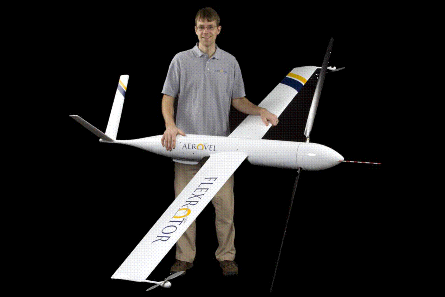A new miniature unmanned air vehicle, the Flexrotor, from Aerovel made its first flight on 7 September.
Flexrotor's first flight focused on autopilot performance checks and station-keeping, finishing with "a soft on-the-spot landing," says Aerovel president Tad McGeer.
Upcoming test flights will expand the hover-mode envelope. Later in the year Aerovel plans to move on to transitions between thrust- and wing-borne flight and evaluation of wing-borne performance, the company says.
McGeer, who co-founded InSitu and led development of the Aerosonde and ScanEagle UAVs, says Flexrotor's first flight was a bit different from his other experiences. "With Aerosonde we launched into flight test by barreling down the runway on a car roof, and with ScanEagle we blasted off with a catapult, so it was a nice change just to lift placidly into the air and park in a hover a few metres off the ground," he says.
The gas-powered, V-tailed Flexrotor takes off and lands nose-up like a tailsitter, although the tail never touches the ground. It also hovers like a helicopter, but cruises horizontally like a traditional fixed-wing aircraft. Thrusters on each end of the 3m (9.8ft) wing are deployed to provide an anti-torque force.
 |
|---|
© Aerovel |
The wingtip thrusters allow Flexrotor to achieve not only vertical take-off and landing, explains McGeer, but also fully-automated turnaround.
"We're designing a lightweight base station for automatic retrieval, parking, refueling and launch," says McGeer. "It should be practical for tough spots, like the windswept, heaving deck of a small boat. Automated turnaround should enable high utilisation, and keep operating costs down."
The propeller-driven, 1.6m-long (5.2ft) UAV can carry payloads up to about 1kg (2.2lb) in the non-rotating nose for about 40h at a time, the company says. With a range of more than 3,000km (1,620nm), the 19kg Flexrotor is designed to challenge the ScanEagle for the commercial and military land- and ship-based surveillance markets, says McGeer. Other potential uses include weather and environmental monitoring and geological survey.
Aerovel intends to field Flexrotor in 2012. Development has been in conjunction with the US Defense Advanced Research Projects Agency, the US Office of Naval Research, Hood Technology Corporation and the University of Washington.
Source: Flight International























